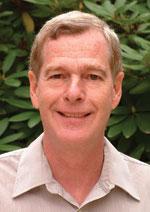
Michael Kellman
Education
B.S., University of California, Berkeley, 1971. Ph.D., University of Chicago, 1977
(R. Stephen Berry). Postdoctoral: University of Oregon, 1977–79 (David R. Herrick); Columbia University 1979–80 (Philip Pechukas); Assistant Professor, Northeastern University, 1981-1987; Associate Professor, Northeastern University, 1987-1989. At Oregon since 1989.
Research
Theoretical dynamics of highly excited molecules are the focus of research in the Kellman group. The goal is to extract new knowledge about dynamics from information encoded in experimental spectra and to apply this knowledge to understand internal molecular energy flow and reaction dynamics. An excellent place to begin to learn about our research is by viewing animations on our website:
http://www.uoregon.edu/~meklab/migration2/
Highly excited molecular vibrational spectra give direct evidence for previously unknown dynamical effects. These include signatures of chaotic classical dynamics and spectral patterns of novel complexity arising from strong interactions of the molecular motions at high energy. Our work seeks a comprehensive framework for analyzing these spectra and the dynamical information which they contain.
In the low-energy regime, spectroscopists use normal mode quantum numbers to interpret the dynamics encoded in spectra. At high energy, including reactive systems, the classical dynamics become much more complicated. In the transition from normal modes to chaos, the normal modes change character, abruptly giving birth to new anharmonic modes – the new natural motions of the molecule.
Mathematically, the birth of the new modes is described as bifurcations of the original low-energy normal modes. We use this knowledge to find new quantum numbers, based on the underlying classical dynamics. These quantum numbers are then used to identify and interpret new spectral patterns.
We are applying these techniques to systems where it was not possible before to obtain dynamical information from interpretation of experiments. One of our principal goals is to extend current methods of spectral analysis to encompass reactive systems undergoing internal molecular rearrangement. Examples of such processes are isomerization of small molecules such as acetylene, and folding processes in larger systems such as polypeptides and even proteins.
We are putting our techniques to work in interpretation of experiments that probe molecules via the time-domain window of ultrafast spectroscopy, as well as the frequency domain of high-resolution spectra. We are able to directly apply the knowledge of cyclical molecular motions that we gain from spectra to simulate time-dependent behavior, including energy transfer processes.
One of the goals of our work on energy transfer processes and internal molecular rearrangements is to test and extend theories of reaction rates. The decoding of complex frequency domain spectra gives us a unique window with which to critically examine fundamental ideas that chemists use to think about chemical reactions, including the idea of a reaction path, and rate theories such as transition state theory.
We are finding that these basic notions are on the whole sound, but their validity depends to a great extent on time scales and excitation processes. On scales shorter than the critical times, there are definite channels for energy flow. This means there is a “window of opportunity” for selective stimulation of energy transfer and reaction pathways. This could prove important for efforts to control molecules at the smallest scales of length and time.
Publications
"Spectral Patterns and Dynamical Bifurcation Analysis of Highly Excited Molecular Vibrations", J. Svitak, Z. Li, J. Rose, and M.E. Kellman, J. Chem. Phys. 102, 4340-54 (1995).
"Algebraic Methods in Spectroscopy", M.E. Kellman, Ann. Rev. Phys. Chem. 46, 395-421 (1995).
"Assigning Spectra of Chaotic Molecules with Diabatic Correlation Diagrams", J.P. Rose and M.E. Kellman, J. Chem. Phys. 105, 7348-63 (1996).
"Nonrigid Systems in Chemistry: A Unified View", M.E. Kellman, Int. J. of Quantum Chem. 65, 399-409 (1997).
M.E. Kellman, article on "Correlation", in press, McGraw-Hill 1999 Yearbook of Science and Technology (McGraw-Hill, New York, 1999).
